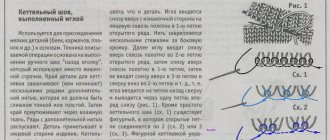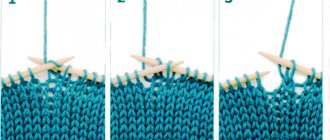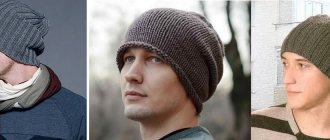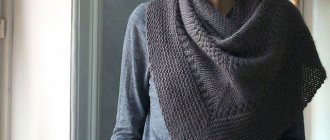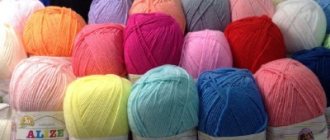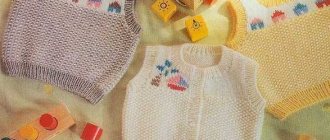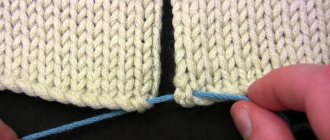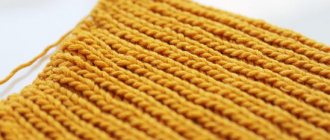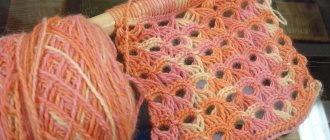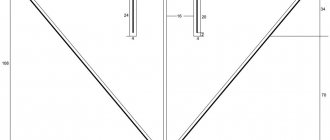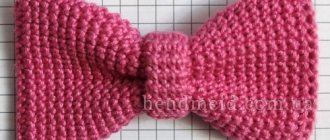A knitted vest is an integral part of the wardrobe of every girl or woman. Some fashionistas have a lot of sleeveless vests in their collections, which allows you to create great combinations of clothes, combining them with different blouses, skirts and trousers. Sleeveless vests can be worn not only in winter and autumn.
They are also worn in spring and summer if they are knitted from cotton or other light threads. If in the cool season vests serve for insulation, then in the summer they complement the image and create a clothing style. Not so long ago, various models of vests that have an unusual shape or are shaped in an unusual way became popular, and today are at the peak of fashion. This is the so-called transforming vest. In this article we will try to look at some models of transformer vests, their diagrams and patterns. In addition, we will look at the technique of knitting them.
Vest "Shifter" with openwork edge
This vest does not have a specific top. It can be worn with the openwork edge down or up.
This is what this transformer looks like when unfolded. It is absolutely simple, and all its charm lies in the beautiful decoration with leaves.
It is classified as transformable because it can be worn upside down or upside down, or pinned in different places, at the waist or chest. This is a model that you can experiment with. This product must be knitted with very thick yarn. Otherwise, the sleeveless vest will not fit well:
Read
Types of yarn overs and knitting techniques
A dense thread is especially important for knitting leaf edging. It must be rigid and voluminous to have an ideal appearance. This transformer must be performed across the canvas. One edge is edged with the “Rice” pattern.
On the second side a pattern of leaves is knitted. The thick yarn makes the item heavy. It is quite rigid, so it holds its shape well. The entire central zone is knitted in the Garter Stitch pattern. Holes for the hands are made in the right places.
Changeling vests can be knitted in different knitting patterns and with different edge designs. Here is another photo of MK knitting such a vest:
Selection of yarn and tools
What yarn to knit a transforming vest with knitting needles from? Patterns and descriptions usually recommend a certain yarn for each specific model, but in reality you can safely experiment.
Thick wool yarn is perfect for a winter product. It is very warm, the item will look stylish, but then the edges of the vest will not flow as much as if the product was made from a thinner yarn. Although there is a way out of this situation: if you prefer bulky yarn, choose knitting needles one or two sizes larger than recommended, then the transformable vest will not only be warm, but soft and airy.
For a stylish accessory for spring and early autumn, thin wool or thicker cotton yarn is suitable. A thread with lurex or small sequins will look very beautiful. The product can be tied with an openwork pattern, then it can be worn in the summer.
Gray transformable vest
This vest has such an unusual design that it can be worn in three different ways. At the same time, it always looks great, even if worn inside out or upside down. If the first photo represents a general view of the transformer with knitting needles, then in the second photo you can take a closer look at its design:
In this image you can see that in the shoulder area there is a slope that forms exactly the line of the shoulders. The armhole line is decorated and tied with another relief, garter stitch. The armhole is very deep and just short of the waist. This vest is made in one continuous piece. It starts from a vertical stripe on the front shelf and continues like a scarf. On one side the binding is knitted with the Rice pattern, and on the other side the “Chess” pattern is knitted, and then the binding. As for the pattern of this model, it is a rectangle. The peculiarity of knitting is to make short rows near the armhole, which will narrow the product at the waist, and narrow the collar near the shoulders:
The presented diagrams show exactly how to perform shortened rows with knitting needles:
How to wear?
Why is such a vest called a transformer? The fact is that in addition to the usual vest, this item can be worn in many ways. For example, as a bactus scarf, draped around the neck, or as a shawl, draped over the shoulders.
The transformable vest (you can see a photo of it in the article) will look great in several wearing options:
- Like a regular long asymmetrical vest, without a fastener, with flowing sides.
- Like a cropped vest if you wrap the edges tightly around your waist and tie in a knot.
- Like an elongated sleeveless vest, if you fasten one edge to the opposite shoulder and pin it with a brooch.
The simplest knitted transformable vest
This original transformable vest is knitted according to a pattern that is an irregular polygon. The model will look most advantageous and interesting if knitted from wavy fantasy yarn. In the photo you can see the pattern with a large elastic band, and this knitting looks great.
Read
Step-by-step knitting of warm pants for a baby
Another model is also very easy to knit. To work, you will need cotton and polyester yarn in any color you like, as well as number eight knitting needles. Garter stitch is performed as follows: purlwise. and persons Only faces should be knitted in rows. loops. The knitted density of the product is 15 p. per 28 r. equal to 10 by 10 cm.
For the back, cast on eighteen links and knit 38 cm in garter stitch, and then bind off the buttonholes. For the front part you need to cast on 55 stitches and also knit the pattern described above. After six centimeters for the holes, you need to close from 34 sts to 41 sts. And in the new strip, instead of these that were closed, dial new sts. After forty cm, you can close all the remaining links.
For the right sleeve with a visual scarf, cast on 36 sts and knit 150 cm with a garter pattern. After this, finish knitting. All that remains is to assemble the transformer vest. The back should be sewn to the front of the product. Do the same with the scarf; it is also sewn on. Eventually you will see holes forming for your arms.
Another vest has a very unusual style. It is made with the simplest knitting of thin threads:
The original model consists of three separate parts, the pattern of which is shown in the photo:
Dimensions in the drawing are in inches. To calculate the dimensions of the pattern in centimeters, you need to multiply these numbers by 2.5.
Colored knitting technique
To create this vest, intarsia is used. In each line we will need two skeins of yarn, two colors. In fact, knitting is very simple, you just have to try it, and I’m sure you will like this technique.
- Step 1 (LS): We wrap the main thread around the additional thread and knit the next loop with the additional thread.
- Step 2 (IS): we throw the additional thread to the front and wrap it around the main thread, so we form a small broach that connects the two threads.
- Step 3 (IS): we throw the main thread over the back wall and knit the next loops with it.
- And for a better understanding, I suggest watching a video that shows in detail how to knit crosswise in two colors.
Rectangular sleeveless vest in two colors
Left side (front)
- Using an additional thread, cast on 48 stitches on long knitting needles and set them aside.
- Using the main thread, we cast on 72 loops on circular knitting needles, the total number of working loops is 120.
- Note: When you add colors, be very careful and follow the photos above.
- 1st row (RS): we knit 72 loops with the main thread, we knit with an additional thread to the end of the row.
- 2nd row (IS): remove 1 loop, knit 47 loops with an additional thread, knit with the main thread to the end of the row;
- 3rd row: remove the loop, knit 71 loops with the main thread, additional loops until the end of the row;
Repeat rows 2 and 3 until the length from the edge is 23 cm (25 cm, 28.5 cm).
Cut the main thread.
Forming the left armhole
Next row (IS) : remove 1 loop, knit 39 additional loops, cut the additional thread, knit 32 knit stitches with a contrasting thread, cut this thread, attach the main thread and knit the remaining loops to the end of the row;
Back
Next row (IS): remove 1, knit 71 loops with the main thread, attach an additional thread and knit it to the end;
Repeat the 2nd and 3rd row from the left side of the front until the length from the counter thread is 30.5 cm (35.5 cm, 38 cm). We finish knitting on the front side and cut the main thread.
Forming the right armhole
Next row (IS): remove 1, knit 39 loops with an additional thread, cut off the additional thread, use a contrasting thread and knit 32 loops, cut this thread, knit with the main thread to the end of the row;
Right side (front)
Next row (RS): remove 1, knit 71 loops with the main thread, attach an additional thread and knit to the end. Repeat the 2nd and 3rd rows from the left side of the front until the length from the contrasting thread is 30.5 cm (35.5 cm, 38 cm). We finish knitting on the front side.
We close the loops (IS): we close 47 loops with an additional thread, cut the thread; Use the main thread to close the remaining loops and cut the thread.
Armholes
Note: Use the instructions below for both openings.
There are ends of our working threads on both sides of the contrasting thread; they need to be secured well with a needle.
We select and close
- From the front side we select 32 loops under the bottom of the contrasting thread on short circular knitting needles; We continue to select 32 loops over the contrasting thread, the total number should be 64 loops.
- Using the tip of the needle, we pinch the contrasting thread and carefully pull it out of the product.
- We close the loops (LS): we close 24 loops with the rest of the fixed main thread, cut it off; We close 16 loops with an additional thread, cut this thread; attach the main thread and bind off the remaining loops;
Using strings at the beginning and end, close any gaps.
We fix the threads and hide them in the product.
So we have a pretty sleeveless vest!
Be inspired, my dears!
Source: https://www.purlsoho.com/create/2014/10/29/sideways-garter-vest/
Source: https://knittingblog.net/zhilet-bezrukavka-pryamougolnik-svyazannyj-poperek-spicami/
Transformable vest made of knitted scarf
A very interesting transformer model, which is made up of a back knitted according to a pattern, as well as a beautiful scarf. The scarf is knitted with a beautiful twisted pattern. Its width should be 108+10 centimeters (cm):
You can knit it by following the master class:
Read
Wear a scarf elegantly: the most complete master class
Rectangular transformable vest
This rectangular transformable sleeveless vest will appeal to many fashionistas. It is very useful when putting together different sets of clothes. This detail is very functional in any wardrobe. She will add a new touch to the classic style of clothing. This vest is knitted using a simple garter stitch pattern. Here you will need to combine two colors of yarn at your discretion. You can put on a sleeveless vest in two different ways, that is, with the light side up, or the dark side up. The combination of two contrasting shades will emphasize the beauty and unusualness of this model. If you lay out the transformable vest on a horizontal surface, you will see that it has the shape of a rectangle with two holes for the arms, that is, with armholes:
Elegant melange
Even a beginner knitter can handle this simple pattern, and thanks to its simple triangular shape, this vest goes perfectly with a dress, trousers or skirt of any cut.
To begin, take needles number 6, cast on seven loops and knit 5 rows using the garter method. In the next rows from each edge we make 115 additions of one loop in a decorative way. We make decorative additions for 4 loops, that is, before and after the edge loops + 3 loops, from the broaches we knit one crossed front loop.
Having knitted about 75 centimeters, we divide the fabric into three parts and begin knitting the armholes. Then we knit all the parts in 43 rows and again connect everything on one knitting needle. We continue decorative increases until there are 241 loops on the knitting needles, then close the edge of the product.
